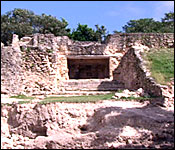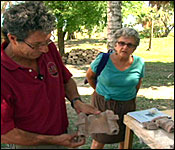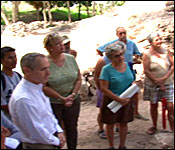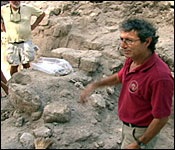


 Belize's most famous Maya Temples are Altun Ha in the Belize District, Xunantunich in the Cayo district and Lamanai in the Orange Walk District. Corozal and Toledo don't factor into the popularity picture probably because they are too far from the main tourist hubs - and, so, sites like Lubantuun and Nim Li Punit in Toledo and Cerros and Santa Rita in Corozal don't get the amount of attention and restoration that sites in the central areas do. But that doesn't mean that they weren't important political and trading centers. That's especially true for Santa Rita which sits just outside of Corozal Town. It was once the capital of Chetumal - and now its pre-eminence is being restored through an effort by the US Government and NICH. Yesterday, Dr. Jaime Awe hosted US Embassy staff at the site and explained the newfound treasures of Santa Rita:..
Belize's most famous Maya Temples are Altun Ha in the Belize District, Xunantunich in the Cayo district and Lamanai in the Orange Walk District. Corozal and Toledo don't factor into the popularity picture probably because they are too far from the main tourist hubs - and, so, sites like Lubantuun and Nim Li Punit in Toledo and Cerros and Santa Rita in Corozal don't get the amount of attention and restoration that sites in the central areas do. But that doesn't mean that they weren't important political and trading centers. That's especially true for Santa Rita which sits just outside of Corozal Town. It was once the capital of Chetumal - and now its pre-eminence is being restored through an effort by the US Government and NICH. Yesterday, Dr. Jaime Awe hosted US Embassy staff at the site and explained the newfound treasures of Santa Rita:..
Jules Vasquez reporting
The Santa Rita Mayan Site on the outskirts of Corozal was once the Capital of Chetumal.
But that was in Ancient Mayan history when Santa Rita enjoyed prominence as a trading center due to is proximity to the Rio Hondo River.
But for the past century Santa Rita and its glorious past had been mostly buried beneath rubble - the product of raiders in the form of Caste War Refugees and amateur archeologists like Thomas Gann who dynamited the site to look for treasures of antiquity.
That was over a century ago - and now Dr. Jaime Awe is leading a project to see if the architecture of Santa Rita can still be reclaimed.
The project is only a month in but what his team ahs found so far is cause for excitement.
While it may look like a mess - and indeed it is because one of the earlier excavations had dug a tunnel right through the center of the main structure, and another had dug a trench through where the stairs were, there are still enough structural clues to put it back together.
Yesterday Awe explained this to a group of visitors including representatives from the US Embassy, which is funding the project.
Dr. Jaime Awe, Director OF Archaeology
 "Even though the early excavations took out the steps there we know where it is, so we can now run it. We called this the stair side incept. We have found the stair side incept on the other side. Now we can just run a line and we will redo that step. You can see the other on one top. This is - when you find stuff like this, that's why we are doing this work because we will be able to breathe new life into this building. Now you can start to see that what look like a blob now we know it had a nice central stairway going up to the top of the temple where there are rooms and then you have the stairway in the middle and then flanking the stairway you have these terraces going off. Because we have enough of three of them we will be able to redo the three terraces on either side of that stairway going up. So, this building will get a new lease on life."
"Even though the early excavations took out the steps there we know where it is, so we can now run it. We called this the stair side incept. We have found the stair side incept on the other side. Now we can just run a line and we will redo that step. You can see the other on one top. This is - when you find stuff like this, that's why we are doing this work because we will be able to breathe new life into this building. Now you can start to see that what look like a blob now we know it had a nice central stairway going up to the top of the temple where there are rooms and then you have the stairway in the middle and then flanking the stairway you have these terraces going off. Because we have enough of three of them we will be able to redo the three terraces on either side of that stairway going up. So, this building will get a new lease on life."
An after-life for a site that was had uninterrupted occupation dating back as many as three millennia until what archeologists call the late post classic period - after the arrival of Europeans, and after the then ruler of Chetumal, Nanchacan used this seat of power to resist a Spanish invasion.
And while the site has been raided and excavated for centuries, not all its secrets have been unearthed.
That was clear when this project to clean up the site, turned into a proper archeological dig.
Dr. Jaime Awe, Director OF Archaeology
"What we have done is trying to give new life to the temple that once stood here."
The principal find so far was buried in this hole - many layers down - through centuries of history - to find a burial site.
Dr. Awe explained the totality of what's been found to a very receptive audience yesterday
Dr. Jaime Awe, Director OF Archaeology
"We have found some evidence right here where these Maya who were living around the site around 1200- 1500 AD dug a hole through the foreground through the floor of the courtyard and they buried at least one perhaps two people inside of that hole. Here you can see that alignment and you can see the hole that was dug through by these post-classic period Maya. Here the guys on top found a lot of smash pottery. That smash pottery ends up to be pieces of these large incense burners. This is the bottom of it and you can see their little feet. That would have been like that standing up and the upper part of it - of this incense burner is where the body was. This was part of the body, the upper part and you can actually see where the arms used to be. The arms are coming out right out here. You can see some of the arms - you start to get the picture now. Here is another arm and this arm is holding a dead bird. If you look carefully his hands are cupped, look at the bird head; you see the eye, beak, so he is holding probably some bird in offering. Down below we found the remains as I said of either one or two humans and right next to it there are two parts; this one, complete but all broken. This one was mostly complete except for one little piece. That object is this little thing right here and that's the tail - that's the only piece that was broken. If you look carefully, you are looking at what kind of bird - it's a pelican."
The perfect bird for a setting on the bay of Chetumal - and a rare treasure of antiquity among many others they did not expect to find in this restorative work.
Dr. Jaime Awe, Director OF Archaeology
"Every once on a while when you are cleaning a lot of the garbage that has been dumped over, this is red paint that is still preserved. It's part of a stucco. These walls were decorated in antiquity with beautiful murals and this is part of that decoration. This could have been part of the - it looks like head. That looks like an eye and he probably had the nose. You can see the little ridge right there where there was a nose there and the head dress was up here and so these building would have been decorated just unbelievably with this kind of stucco decoration."
But that's just the good fortune they have been having In clearing away all the rubble of two centuries of advanced ruin.
Now, the U.S. Ambassador's Fund for Cultural Preservation has provided one hundred thousand US dollars for this project which may unearth more treasures but will still not yield all the secrets of Santa Rita.
As a part of the effort, two of the Fort Barlee towers in downtown Corozal are also being restored. Fort Barlee was used as a defence during the Caste War against the marauding Icaiche Indians.



